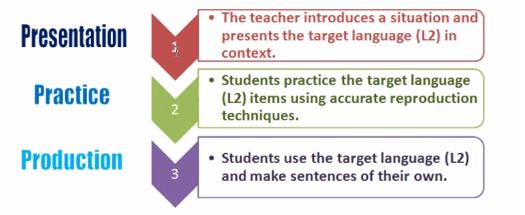PPP Teaching Methodology
1. Click to play this six-minute video describing PPP methodology.
..... Please wait a few seconds for the video to load.
2. Read the text below to supplement and reinforce the information on the video.
Basic Concepts
Though there are many approaches to teaching methodology in TEFL/TESOL, two teaching methods are most commonly taught in TEFL certification programs. These methods are “PPP” (present, practice and production) or “ESA” (engage, study and activate). That doesn’t mean they are the best approaches. They are just the most well-known approaches and more likely to be requested by employers or Directors of Studies (DOS). Thus we are going to concentrate on those two approaches.
“PPP” Presentation, Practice and Production

“Presentation” involves presenting the target language (the language to be taught to the students) to the students generally through eliciting and cueing of the students to see if they know it and then providing the language if no one does.
The target language is usually put on the board either in structure (grammar-type) charts or in dialogs. Presentation features more “teacher talk” than the other stages of the lesson, generally as much as 65-90% of the time. This portion of the total lesson can take as much as 20-40% of the lesson time.
Next comes “Practice” where the students practice the target language in one to three activities that progress from very structured (students are given activities that provide little possibility for error) to less-structured (as they master the material).
These activities should include as much “student talk” as possible and not focus on written activities, though written activities can provide a structure for the verbal practices. Practice should have the “student talk time” range from 60-80 percent of the time with teacher talk time being the balance of that time. This portion of the total lesson can take from 30-50% of the lesson time.
“Production” is the stage of the lesson where the students take the target language and use it in conversations that they structure and use it to talk about themselves or their daily lives. Production should involve student talk at as much as 90% of the time and this component of the lesson should take as much as 20-30% of the lesson time.
As you can see the general structure of a PPP lesson is flexible, but an important feature is the movement from controlled and structured speech to less-controlled and more freely used and created speech. Another important feature of PPP is the rapid reduction of teacher talk time and the increase in student talk time as you move through the lesson.
One of the most common errors untrained teachers make is that they talk too much. EFL students get very little chance to actually use the language they learn and the EFL classroom must be structured to create that opportunity. See the paragraph on Pair work and Small Groups below.
3. Watch this eight-minute video describing PPP methodology.
You can often hear criticism of PPP as being too rigid and too grammar based, but there is no need to use PPP that way. CELTA programs in particular approach lessons with a very grammar-oriented focus. There is no better way to turn off your students, to bore them and have them hate the study of English.
4. A better way to use PPP is to teach functions. And here is a good short blog post to turn the whole grammar problem around. Just click on the image below to open a new window and find the article (link opens in a new window):
5. Some TEFL training programs will teach a method called Task Based Learning or TBL – which is really quite similar to teaching functions with a PPP structured lesson. Don’t let all the abbreviations get you confused. The basic ideas are 1. Teach something to your students, ideally something useful and relevant to them, 2. Have them practice it in a structured way that assures success and, 3. Allow them more freedom to apply that language to their own circumstances AND/OR (in TBL) a task they need to complete such as a job application or interview, writing an email to their company, documenting a work process or procedure, etc.
Here is a rather dense, but very thorough overview of TBL and you will see how it fits very well with PPP and in the following lesson/topic, with ESA. The video is about 15 minutes long.


